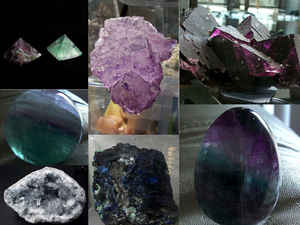Maine State Mineral (Gemstone)
Tourmaline
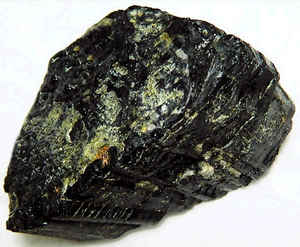
Complex Aluminium Borosilicate
Adopted in 1971.
Tourmaline, (Complex Aluminium Borosilicate,) was adopted in 1971 as Maine official state mineral. It occurs as lustrous, elongate crystals which commonly have a rounded triangular cross section and narrow grooves running parallel to their long direction.
Tourmaline: Maine State Mineral (Gemstone)
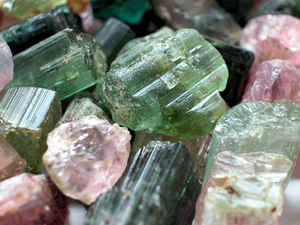
Tourmaline is a crystal boron silicate mineral compounded with elements such as aluminium, iron, magnesium, sodium, lithium, or potassium. Tourmaline is classified as a semi-precious stone and the gemstone comes in a wide variety of colors. The name comes from the Sinhalese word "Turmali" or "Thoramalli," which applied to different gemstones found in Sri Lanka.
Tourmaline is actually a group of several different minerals which have similar crystal structures, but complex and variable chemical formulas. The exact species of tourmaline is determined by the number of elements present. The most common species in Maine is schorl, a black, iron-bearing tourmaline. The colorful, but less common, species found in Maine is elbaite, named after the island of Elba, Italy. Tourmaline occurs as lustrous, elongate crystals which commonly have a rounded triangular cross section and narrow grooves running parallel to their long direction. The crystals range in size from microscopic to over a foot long. The best examples in Maine are found in a very coarse-grained type of granite called "pegmatite". The slow cooling and solidification of the pegmatite veins allowed the mineral grains to grow to much larger sizes than in ordinary granite. The black tourmaline crystals and many of the brightly colored ones are usually encased in the surrounding rock. However, conditions in some places favored the development of open cavities in which elbaite crystals grew with greater perfection and clarity. These pegmatite "pockets" are the source of Maine's finest gem tourmalines.
The crystals range in size from microscopic to over a foot long. The best examples in Maine are found in a very coarse-grained type of granite called "pegmatite". The slow cooling and solidification of the pegmatite veins allowed the mineral grains to grow to much larger sizes than in ordinary granite. The black tourmaline crystals and many of the brightly colored ones are usually encased in the surrounding rock. However, conditions in some places favored the development of open cavities in which elbaite crystals grew with greater perfection and clarity. These pegmatite "pockets" are the source of Maine's finest gem tourmalines.
Several spectacular tourmaline pockets were discovered in the Dunton Mine in Newry, Maine, in 1972. Many fabulous red and green crystals were found, including the ten-inch "Jolly Green Giant," which is now in the National Museum of Natural History in Washington, D.C.
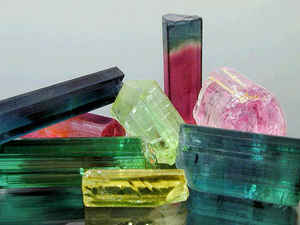
Tourmaline comes in many colors such as blue, yellow, pink, red, black, green and clear. Tourmaline comes in many colors - but primarily in pink and green. It is beautiful in rings, necklaces, and pendants.
Colors:
- Indicolite (blue or blue-green) - moderately scarce and expensive in fine qualitities.
- Rubellite (red) - moderately scarce and expensive in fine qualitities. Often badly included.
- Bicolor or tricolor tourmaline - shows multiple color zones throughout the crystal. Highly prized when the colors are well divided and vivid. Often badly included and subject to fracture along the color transition line.
- Watermelon tourmaline - has a red central core surrounded by green, resembling the cross section of a watermelon. Often cut in thin slices to show the colors to best advantage.
- Schorl - black tourmaline.
- Dravite - brown tourmaline.
- Chrome tourmaline - vivid green. Derives its color from chromium. Appears red when viewed through a Chelsea filter (emerald filter). Fairly scarce and expensive.
- Achroite - colorless tourmaline. Fairly rare.
OCTOBER Birthstone: Tourmaline
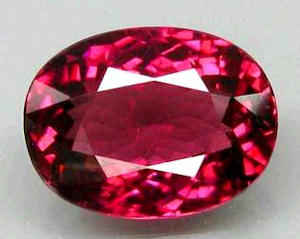
Tourmaline has become a favorite gemstone among jewelry designer, and gem collectors the world over. Since it is available in a wide variety of colors, it is ideally suited to almost anyone's taste. Tourmaline also is known for displaying several colors in the same gemstone. These bi-color or tri-color gems are formed in many combinations; gemstones with clear color distinctions are highly prized. One multi-color variety is known as watermelon tourmaline, and features green, pink, and white colors bands; to resemble its namesake, the gemstone is cut into thin slices having a pink center, white ring, and green edge.
Maine Laws
The law designating the Tourmaline as the official Maine state mineral is found in the Maine Revised Statutes, Title 1, Chapter 9, Subchapter 1, Section 213.
Title 1: GENERAL PROVISIONS
Chapter 9: SEAL, MOTTO, EMBLEMS AND FLAGS
Subchapter 1: GENERAL PROVISIONS
§213. OFFICIAL MINERAL
Tourmaline shall be designated as the official mineral for the State of Maine. [1971, c. 50,
(NEW).]
SECTION HISTORY
1971, c. 50, (NEW).
Minerals, & Gems

Gemstone, Minerals, Rocks





